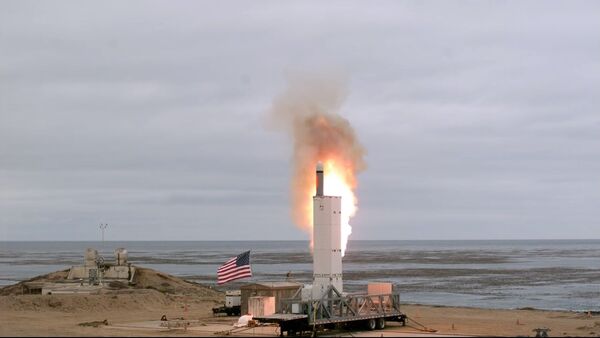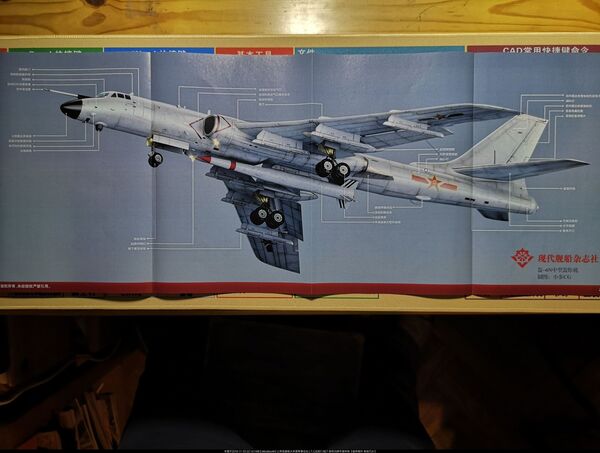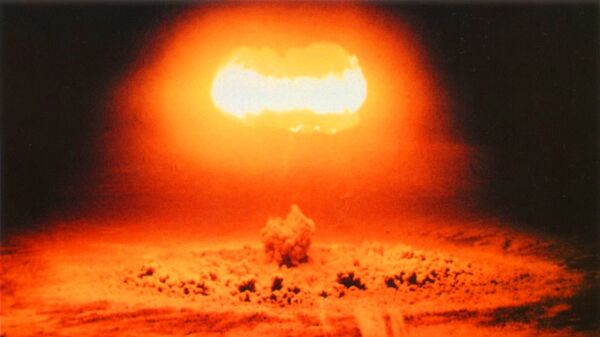‘Peaceful Coexistence Cannot be Begged For’
“China needs to expand the number of its nuclear warheads to 1,000 in a relatively short time,” Hu wrote in a Friday op-ed in the Global Times. “It needs to have at least 100 Dongfeng-41 strategic missiles. We are a peace-loving nation and have committed to never being the first to use nuclear weapons, but we need a larger nuclear arsenal to curb US strategic ambitions and impulses toward China.”
The journalist urged Beijing not to be indifferent toward the strategic value of simply possessing nuclear bombs, which can serve as deterrents. The Federation of American Scientists estimated in 2015 that the People’s Republic of China has 260 nuclear weapons.
“Don't be naïve. Don't assume that nuclear warheads are useless. In fact, they are being used every day as a deterrent to shape the attitudes of US elites toward China. Some Chinese experts say we don't need more nuclear weapons, I think they are as naïve as children,” Hu said.
Hu urged that contrary to critics of his suggestion, the label of “warmonger” should instead be applied to US politicians “who are openly hostile to China.”
“Peaceful coexistence between the two countries is not a thing that can be begged for; it's shaped by strategic tools. This is particularly true as we are facing an increasingly irrational US, which only believes in strength. We don't have much time debating the need for increased nuclear warheads, we just need to accelerate the steps that make it happen,” Hu said.
US Aims to Hem China In
Hu’s words come as the US moves to station missiles and bombers just off the East Asian coast, near a string of islands Beijing calls the First Island Chain. The formation includes not only hotly contested Taiwan and nearby islands, but also Japan, Borneo, the Philippines, and Kuril Islands.
In March, the US Marine Corps pitched a reprioritization toward long-range missiles to the Senate Armed Services Committee, with the intention of combining them with rapidly deployed expeditionary forces to set up “no-go zones” on islands early in a military campaign against China.
“A ground-based anti-ship missile capability will provide anti-ship fires from land as part of an integrated naval anti-surface warfare campaign,” the Corps said in a letter to lawmakers obtained by Defense News. “This forward-deployed and survivable capability will enhance the lethality of our naval forces and will help to deny our adversaries the use of key maritime terrain.”
While some of those weapons include anti-ship missiles launched by air and sea, they also include a new development of the Tomahawk cruise missiles modified for surface launch, which have a roughly 1,000-mile range and would be fired by the Aegis Ashore radar system. The land-based “Maritime Strike Tomahawk” isn’t expected to be operational until 2023, but Russia especially has expressed ire at the mere development of the weapon.

However, one of the Aegis Ashore sites intended for construction in the Japanese city of Akita was dropped by the Defense Ministry on Wednesday due to heavy opposition by locals, according to Kyodo News Agency. It’s unclear when Tokyo will select another site or where that will be.
Until last August, such ground-based missiles were banned by the Intermediate-Range Nuclear Forces (INF) Treaty the US signed with Russia, but within weeks of that treaty being allowed to lapse by Washington, the Pentagon was testing missiles that violated the treaty’s prescriptions.
This is in line with the Pentagon’s conclusions in the 2018 Nuclear Posture Review, which argued the rise of China and return of Russia as world powers capable of challenging American hegemony heralded a “return to Great Power competition.”
The INF Treaty was drawn up in 1987 to address the severe danger of war created by the US basing Pershing II intermediate-range ballistic missiles in Europe with the ability to reach Moscow in just six to eight minutes. With such little time to react, the possibility of misreading a false alarm and ordering a nuclear response was palpable - as very nearly happened during the hyper-realistic Able Archer NATO war games in 1983.
The basing of such missiles close to China revives this eminent danger.
‘Peace on More Favorable Terms’
Chinese military experts quoted in another article by the Global Times on Friday noted that US policy toward nuclear weapons differs greatly from China’s. While Beijing has just a few hundred weapons and maintains a “no first use” pledge, Washington has more than 5,000 nuclear weapons and has never held to that logic. Indeed, the US is the only country to have ever used nuclear weapons in war, when it killed hundreds of thousands of Japanese civilians in the nuclear bombings of Hiroshima and Nagasaki in August 1945.
But more than that, the Trump administration has developed a new type of nuclear weapon with a smaller explosive yield, the W76-2, which nuclear deterrence scholar Andrew Facini called in an article in the Bulletin of the Atomic Scientists a “low-yield, high risk” device.
Last June, the US Joint Chiefs of Staff accidentally published an unclassified document that made the case for using nuclear weapons in an otherwise-conventional war if they “could create conditions for decisive results and the restoration of strategic stability.”
“Employment of nuclear weapons can radically alter or accelerate the course of a campaign,” the military leaders argued. “A nuclear weapon could be brought into the campaign as a result of perceived failure in a conventional campaign, potential loss of control or regime, or to escalate the conflict to sue for peace on more-favorable terms. The potential consequences of using nuclear weapons will greatly influence military operations and vastly increase the complexity of the operational environment.”
Chasing the Nuclear Triad
“The complete development of a nuclear triad - nuclear weapon launch capabilities from sea, land and air - is necessary for China as the US' strategic weapons are a threat to China, and China needs to continuously upgrade its nuclear arsenal,” the Global Times paraphrased Chinese military expert Song Zhongping as saying.

The ability to guarantee a nuclear response strike by land, air and sea is held by only a handful of nations: the US, Russia and India. However, in recent years China has made headway toward the achievement, which promises an effective deterrent to an attempted nuclear decapitation strike.
On the one hand, the modification of a DF-15 ballistic missile into an air-launched version capable of being fired by a Xi’an H-6N bomber would give Beijing a third - if unconventional - method of nuclear reach. However, a more typical air delivery could also come via the H-20 stealth bomber, which Sputnik reported could debut at the Zhuhai Air Show later this year. China already possesses submarine-launched ballistic missiles and land-based intercontinental ballistic missiles, the other two arms of the triad.



